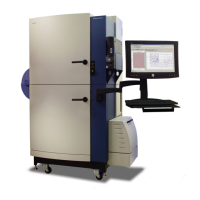Data Processing Algorithms
280 0112-0109 H
The results show only numbers above zero. The subtract bias algorithm
places the data in a readily interpretable form. The positive control
wells at Sample 4 range from 93–109% positive. In contrast, the
negative control wells remain close to zero percent positive throughout
the experiment. The experimental wells show two wells with about 90%
activity and one with 79% activity at Sample 4.
Response Over Baseline
The response over baseline correction algorithm compensates, to a
certain extent, for variations within a single well.
Determining Response Over Baseline Correction
The correction factor is derived by calculating the mean fluorescence
counts in each well between the baseline start and end samples (see
below).
All samples taken from a particular well are divided by their well-
specific mean baseline correction factor. For example, all samples from
A1 are divided by 8200, A2 by 8533, etc.
The results of applying the response over baseline correction factor are
presented in the table below. Note the data is displayed is displayed as
Sample Time
Well
A1
– Ctrl
A2
– Ctrl
A3
– Ctrl
A4
Exp
A5
Exp
A6
Exp
A7
+ Ctrl
A8
+ Ctrl
A9
+ Ctrl
1 0 8000 8500 9500 8200 9200 8800 10000 9500 8700
2 5 8200 8600 9400 8300 9000 9000 9500 9700 9000
3 10 8400 8500 9200 8500 9000 9100 9700 9700 9400
Mean 8200 8533 9367 8333 9067 8967 9733 9633 9033
Note: In actual practice, data from all 96 wells are included in the
calculations, but in this example, data from only nine wells are
presented, to simplify the examples.

